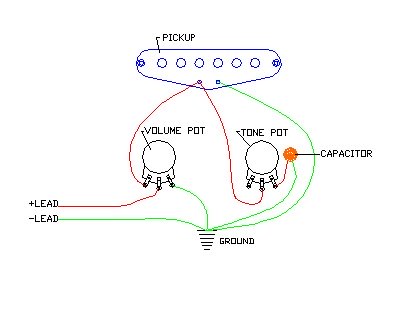|
Understanding Electric Guitar Capacitors

Before I start with the guitar capacitors, I'd like to apologize up front folks for my hokey looking diagrams. I've got an old version of Autocad that I own, and know how to use. If I wasn't so lazy I'd get some new drawing software, as a matter of fact any recommendations would be much appreciated. I've been poking around other sites trying to see what others have to say about tone capacitors. The party line on capacitors seems to be that they are an energy storage device, and regulate frequency depending on the size of the capacitor. Well this is all true, and it's also vague. A long time ago, when I was in college, I thought I wanted to be an electrical engineer. After three long, horrid years of all nighters, I realized that EE wasn't for me. I opted out, and got a degree in math instead, the path of least resistance to a degree. The point is I learned a little bit about how capacitors work. Capacitors do store energy in a static sense. Like when you charge up the capacitor in your camera to take a flash picture. However in a dynamic sense, like a pickup signal from a guitar, the job of the guitar capacitor becomes quite a bit more complex. I'm not going to try and explain how a guitar capacitor filters out frequency. First because it involves some calculus, and second because I don't remember, and it's not important in my or your search for tone. What's important is understanding where to put capacitors in the signal path, and what size capacitors to choose. Take a look at my drawing above. What I've done is try and illustrate in the simplest possible format how a pickup, volume pot,tone pot, and guitar capacitor all interact. In fact I could have left the volume pot out for even more simplicity. The Volume pot is very simple. If you set the volume at ten, or full volume, there is a direct connection between the red lead from the pickup, and the red lead out to the output jack. As you turn the volume towards zero the resistance increases, and incrementally more signal is sent to ground. Until such point that the volume pot essentially short circuits the red pickup lead to ground, canceling all signal. The tone pot works in the same fashion. When the tone pot is set to ten, there is no connection between the guitar capacitor, and the signal wire. In effect this is what your guitar would sound like with no tone control. When you start turning the tone pot down towards zero. You gradually begin to send signal through the capacitor to ground. Once you reach zero, or off, your signal wire is directly connected to the capacitor. So what's the capacitor do you ask? The guitar capacitor is a high pass filter. It blocks low frequency signal, and allows high frequencies to pass, thus "High Pass". If you've ever opened up a cheap two way speaker, you'll most likely find a single capacitor in line to the tweeter. This is a first order crossover, and that is what you've got in the guitar. The frequency cutoff is determined by the size of the capacitor. There are other variables like the impedance of the pickups, but for this exercise let's stick to size of capacitance. As you turn your tone control towards ten, or full on, the resistance between the signal and the capacitor grows, up until the capacitor is no longer in the circuit. So as the circuit is closed, less signal is sent to the capacitor, and less high frequency signal is sent to ground, so your sound becomes progressively brighter. Essentially the capacitor allows high frequency signals through, and grounds them out, just like turning down a treble knob. Fender's mainstay is the .022 microfarad capacitor. You'll find this size most frequently on any of their wiring diagrams. If you increase the size of the capacitor, you effectively lower the frequency cut off point. As the tone control is lowered, the tone becomes deeper or bassier, because the cut off point has been lowered. This of course results in lower frequency signals being bled off to ground. As is often the case when dealing with the electric guitar, the sound you want is usually different from what someone else wants. I've used .001uf capacitors up to .01uf capacitors in my tone circuits, which is a pretty good range to stay in. The most important thing is to have some fun experimenting. I Hope this helped, and good luck JB. There are two footnotes I'd like to add. First, for the electrical purist, when the trim pot is turned all the way down, the signal is not totally cut off. Rather, say in the case of a 250,000 ohm pot, you have a 250,000 ohm resistor, rather than a broken circuit. Second, if you're at the radio shack and can't find the capacitor value you want put a few in parallel to get the value, for example, two .022uf capacitors in parallel, create one .o44uf cap. Conversely you can add capacitors in series using this formula, 1/c+1/c=1/c, so if you have two 0.1 uf capacitors, adding them in series yields a .05uf capacitor.
Return from Electric Guitar Capacitors to Electric Guitar info home. |




